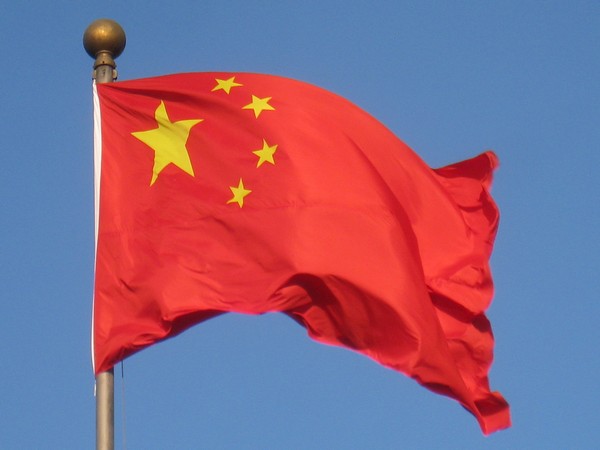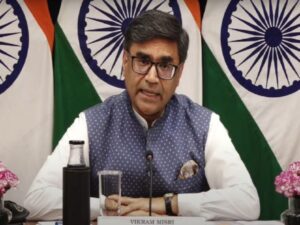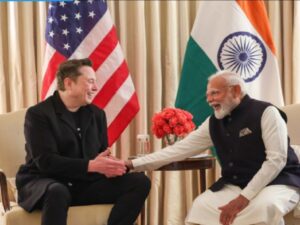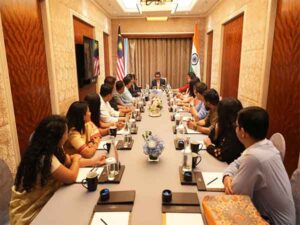China’s rising coercion redounds on its own head
Hong Kong, April 27 (ANI): The world is fearfully looking at the specter of intensifying strategic competition between China and the USA. Yet China was the first to throw down the gauntlet, to incessantly challenge international regulations and bully others with its authoritarian style of government.

Beijing’s own policies, such as the militarization of South China Sea outcrops and interference of other nations’ vessels, caused the USA to shift from a policy of engagement to one of managing competition. In the annual Threat Assessment of the US Intelligence Community, released by the Office of the Director of National Intelligence (DNI) in February, the conclusion was this: “China’s Communist Party (CCP) will continue efforts to achieve President Xi Jinping’s vision of making China the preeminent power in East Asia and a major power on the world stage. As Xi begins his third term as China’s leader, the CCP will work to press Taiwan on unification, undercut US influence, drive wedges between Washington and its partners, and foster some norms that favor its authoritarian system.”
Secondly, “Beijing is increasingly combining growing military power with its economic, technological and diplomatic influence to strengthen CCP rule, secure what it views as its sovereign territory and regional preeminence, and pursue global influence.”
And thirdly, on the other hand, “China faces myriad – and in some cases growing – domestic and international challenges that probably will hinder CCP leaders’ ambitions. These include an aging population, high levels of corporate debt, economic inequality, and growing resistance to the People’s Republic of China’s (PRC) heavy- handed tactics in Taiwan and other countries.”
https://www.upsc.gov.in/FR-CSM-22-engl-230523.pdf
The DNI also considers it certain that Beijing will use whole-of-government tools to “demonstrate strength and compel neighbors to acquiesce to its preferences, including its land, sea and air claims in the region and its assertions of sovereignty over Taiwan”.
France’s President Emmanuel Macron’s recent visit to China illustrates the clout that Beijing now possesses, with this European leader sickeningly surrendering to Xi’s narrative that outside powers should not interfere in the Taiwan issue. The DNI also predicted that China will attempt to expand its influence abroad so others will view it as a champion of global development – through such efforts as the
https://www.upsc.gov.in/FR-CSM-22-engl-230523.pdf
Belt and Road Initiative (BRI), Global Development Initiative and Global Security Initiative. Xi is hawking these to induce others to depart from Western- and US-led forums and frameworks, but the ulterior motive is always to enhance China’s narrative and model of authoritarian politics.
A recent example was wolf-warrior extraordinaire Lu Shaye, China’s Ambassador to France, who claimed former Soviet countries don’t have “effective status in international law because there was no international agreement to materialize their status as sovereign countries”. Lu was attempting to defend Vladimir Putin’s 2014 annexation of the Crimea, and deny Ukraine’s legal existence.
Of course, this ridiculous notion reflects China’s tacit support of Putin’s war in Ukraine where. To defend the indefensible, China’s unquestioning support for Russia leads to such absurd statements. Beijing pretends it can be a neutral arbiter in the Ukraine war, but nothing could be further from the truth. Furthermore, China thinks it can embolden its own case that Taiwan is not a nation either. The Chinese ambassador’s convoluted thinking, doubtlessly reflecting internal guidelines, created a storm of protest around Europe, including former Soviet states.
Returning to the aforementioned BRI, China is struggling under the burden of spiraling bad debts. New York-based Rhodium International estimates that USD78.5 billion in Chinese loans has been renegotiated or written off since 2020. Rhodium’s research calculated that these bad debts, rapidly turning into an albatross around China’s neck, are more than four times the USD17 billion in bad debts chalked up from 2017-19.
Nobody really knows how much money China has lent under Xi’s blue-ribbon BRI, but it could be in the order of USD 1 trillion. Yet more and more countries are being pushed to the brink of insolvency, their economies wracked by COVID-19’s impact. Cracks are showing, but China cannot reverse the course it has charted – the BRI is Xi’s brainchild, the “project of the century”, and it goes without saying that this Chinese demigod never makes mistakes.
As China prepares to celebrate a decade of BRI, its own domestic economy is struggling, but still it must bear the burden of being an emergency lender to such countries. This will further increase their dependence on the authoritarian state, even though things are grim at home. New figures reveal an unemployment rate of 19.5% for youngsters in the 16-24 age bracket in China; this compares to 7.5% in the USA.
This perhaps contributes to another reason why Xi is so keen to emphasize the Global Development Initiative and Global Security Initiative, as these ambiguous efforts will continue to keep these same BRI countries under China’s thumb. China claims nearly 70 countries have joined the Group of Friends of the Global Development Initiative.
Even though Taiwan remains under direct and constant military threat from China, there is a danger that Xi will be tempted to pursue a short, sharp conflict elsewhere. As new kid on the block, China might see many advantages in a swift and decisive military victory on its periphery. Not only would it satisfy the People’s Liberation Army’s (PLA) keenness to prove its mettle, but it would demonstrate to the world that China is serious about exercising its muscle.
Scott Savitz, a senior engineer at the RAND Corporation, pondered: “China may believe a quick and decisive military victory could help to establish the perception that it is not only an economic power of the first rank, but also a military one … It could serve as a palpable symbol of China’s re-ascendance to global leadership.” Xi has been unafraid to push others around. As a former Chinese foreign minister explained, “China is a big country and other countries are small countries, and that’s just a fact.”
Which country would make an appropriate victim, then? Savitz picked out either Vietnam or India as being the most likely. “Neither has alliances with the United States, and US intervention on behalf of either would be extremely unlikely. (It is particularly implausible that a US president would send Americans to die in Vietnam on behalf of the communists in Hanoi.) China could use its massive ground-centric forces to overrun either country’s land border with it, while also testing its burgeoning air, maritime, cyber, space and electronic warfare capabilities for future use.”
The American continued: “At a time when China is experiencing copious internal discontent, and when India has supplanted it as the world’s most populous nation, defeating India in a limited border war might be a way for China to reassert itself for both domestic and international consumption. China’s elevation advantage along the Tibetan-Indian frontier was one of many strengths that enabled it to vanquish India in a limited war in 1962. It might be confident – perhaps overconfident – of doing so again, although India is now a nuclear power and a new war might not be so limited as the last.”
China is, of course, an expert at manipulating pretexts, and it could take the form of a clash along the Sino-Indian border or a naval confrontation in the Indian Ocean. As for Vietnam, are match for the PLA could help obliterate the memory of its unsuccessful incursion in 1979.
Savitz also speculated: “Disputes over maritime borders and control of islands, which have resulted in numerous clashes at sea, could likely provide a justification for war whenever China wanted to create one. A tiff between Vietnam and either Laos or Cambodia, both of which have been cultivated by China, could also be magnified into a larger Sino-Vietnamese conflict.”
Yes, the threat against Taiwan is the most ominous, but the world needs to pay heed to the possibility of China instigating something much smaller scale in the interim to rally domestic support and to put the world on notice.
Savitz concluded: “China may anticipate that victory against India or Vietnam would elevate perceptions of its military prowess and enable it to better hone its forces for future combat. However, it may miscalculate the level of difficulty of such a war, its duration, the potential for escalation or other repercussions; Russia certainly did in Ukraine.”
For years, the CCP has nurtured delusions of grandeur under Xi’s notion of the great rejuvenation of the Chinese nation. As one martially minded Chinese netizen wrote on
Chinese social media about Taiwan, in the twisted logic that the CCP has encouraged: “The motherland must be reunited, or else what are we doing on earth? How else are we going to fight against America? What else do we need so many nuclear bombs for?” Indeed, why is Xi investing so much so quickly in the PLA, a question that Beijing has not satisfactorily answered.
Earlier this month, Philippine President Ferdinand Marcos Jr announced four additional military bases on Filipino territory where US military forces can operate. Marcos stated, “It seems to me, that the future of the Philippines, and for that matter the Asia-Pacific region, will always involve the United States.” This is precisely the sentiment that China loathes, but in fact it is Xi’s own aggressive and warmongering policies that pushed Manila into giving the USA greater access. Furthermore, in April the two countries conducted their largest ever bilateral military Exercise Balikatan.
China’s obstreperousness has also forced Japan, which for so long pursued a pacifist approach to security, to review its defense posture. For decades, Tokyo refused to spend more than 1% of GDP on defense, but it has now vowed to double that by 2027. This is a dramatic escalation, but China has only itself to blame. Among new areas of expenditure are long-range strike weapons like Tomahawk cruise missiles and hypersonic missiles.
Just years ago, it would have been unthinkable for Japan to covet such weapons, but China’s intrusions in Japan’s southwest archipelago have caused a serious strategic about-turn. Japan has also sealed defense cooperation agreements with India (2020), Vietnam (2021), Australia (2022) and the UK (2023).
Japan’s National Security Strategy (NSS), released in mid-December 2022, unequivocally warned: “…Japan’s security environment is as severe and complex as it
has ever been since the end of World War II.” The NSS added, “…China’s current external stance, military activities and other activities have become a matter of serious concern for Japan and the international community, and present an unprecedented and the greatest strategic challenge in ensuring the peace and security of Japan…to which Japan should respond with its comprehensive national power and in cooperation with its ally, like-minded countries and others.”
Provocative border clashes along their shared mountainous border also abruptly woke India up to China’s true intentions. Then, on 24 April, Australia released a redacted copy of its Defence Strategic Review, another direct response to the remarkably swift modernization of the PLA. Chinese economic coercion in regard to products like wine, barley and coal showed Canberra that China cannot be trusted.
China complains that the USA is forming alliances to contain it. In a sense, it is correct, but it is only because of China’s obvious track record of coercion, lies, aggression and dismissal of international norms. One can only lament that China refuses to look at itself in the mirror, despite all the national hubris and vanity that Xi has promoted.
The DNI report correctly pointed out: “Beijing uses a sophisticated array of covert, overt, licit and illicit means to try to soften US criticism, shape US power centers’ views of China, and influence policymakers at all levels of government … PRC actors have become more aggressive with their influence campaigns, probably motivated by their view that anti-China sentiment in the United States is threatening their international image, access to markets and technological expertise. Beijing’s growing efforts to actively exploit perceived US societal divisions using its online personas move it closer to Moscow’s playbook for influence operations.”






